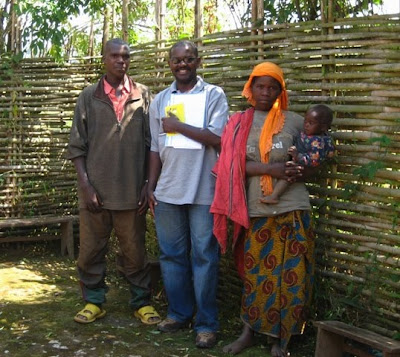
The next round of interviews took us to the
Now I remember using bamboo for goalposts, but it plays a bigger part in life here. For a start you make your house out of it, your fence out of it, your bowls, your bags, your furniture out of it….. Now that it’s banned to go into the forest and cut it, it costs around a day’s wages for one piece. So the temptation to go and get some is still high, despite the risks.
Roof freshly made of bamboo sheathing, ‘ingombo’ – this’ll last about 2 years
A house revealing its bamboo structure.
Lucky man with some bamboo on his land starting up a basket
Preparing a plot for planting with the bamboo forest on the hills behind
Between the villages and the bamboo is the tea plantation – it creates a few seasonal jobs but only for a strong and lucky few.
So most people work their own land and do some seasonal agricultural work. The soil here is not good away from the forest, so everyone wants some livestock and grass to make compost. Even finding grass isn’t easy and often involves running risks in the forest. These days money from tourists is put back into helping with these things and a goat can turn up on your doorstep.
Everyone brings their produce to market – at this time of year that means lots of spuds. It’s amazing in these places, absolutely no noise, no cars, no planes, no prams, no pedestrian crossings, no lawnmowers - just the murmur of voices negotiating a deal on market day.
And the streets quickly quieten down again.
And get noisy again to chuckle at me.
Generations in the village – perhaps an example for the youngsters to stay off the local ale.
Some young spuds growing up quickly. The forest behind them is Kibera NP in
Youngsters making their way to school. New schools are cropping up in many towns now where previously children had to walk for hours on end to get to the nearest one. The governmental plan involves people moving into village centres now so they can provide things like water and power to them more easily in the future.
The project I’m helping on rewards villages for reduced forest use which includes money going to community bamboo and tree plantations for future use and at least one health insurance for each household. So we set about talking to people about the forest, to see how not going there is affecting their lives and where they manage to get things.
Joseph with a fond farewell from an older interviewee.
Myself, Solange and Rabaho, who remembers (a little) about the village pre-christianity.
Young couple with a nice bamboo fence.
Some of the answers make you realise the real difficulties people face here. Many people can’t even afford seeds to plant on their land. Up until two years ago there were bandits and militias using the forest. Theft of money and livestock was common and going to the forest a very risky business. Other people talk about strange dogs called mujeri coming some years with bites that kill people. There are many young widows in villages like this, who have to send their children out to help get firewood or look after the goats.
Some people are very interested in what you’re doing. Chinese whispers means people can sometimes get very mixed up about what you're doing there.
Morning mist around the holy town of
And some towny kids with their fancy water.


























No comments:
Post a Comment